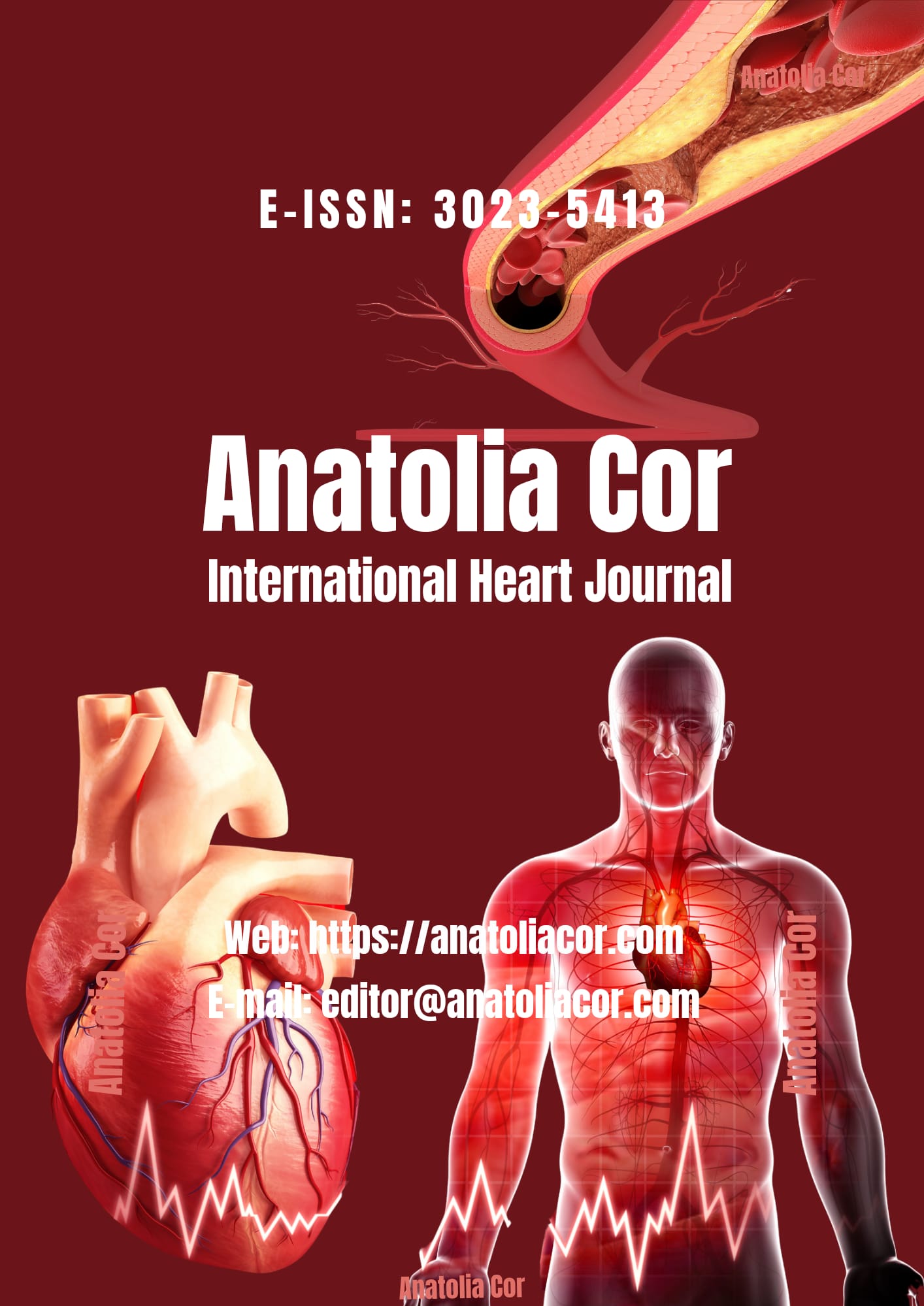Kalp Hastalıklarında Yapay Zeka
Derleme Makale
DOI:
https://doi.org/10.5281/zenodo.13142328Anahtar Kelimeler:
Kalp Hastalıkları, Yapay ZekaÖzet
Kardiyovasküler hastalıklar dünya çapında ölüm oranlarına bakıldığında en yaygın ölüm nedenidir. Ölüme sebebiyet veren kalp rahatsızlıklarının teşhis ve tedavisinde farklı biyomedikal teknolojiler kullanılmaktadır. Bu biyomedikal teknolojilerden biri de Yapay Zeka kullanımıdır. Yakın gelecekte, makine öğrenimi, derin öğrenme ve bilişsel hesaplama gibi yapay zeka teknikleri, kardiyovasküler hastalıkların teşhis ve tedavisinde kritik bir rol oynayabilir. Bu hastalıkların tanısında hassas sonuçlar ortaya çıkarabilir.
Referanslar
Clark H. Ncds: a challenge to sustainable human development. The Lancet 2013; 381: 510–1. doi: https://doi.org/10.1016/S0140- 6736(13)60058
Krittanawong, C., Zhang, H., Wang, Z., Aydar, M., & Kitai, T. (2017). Artificial intelligence in precision cardiovascular medicine. Journal of the American College of Cardiology, 69(21), 2657-2664.
Rosenblatt F. The perceptron: a probabilistic model for information storage and organization in the brain. Psychological Review. 1958; 65: 386–408.
Koza JR, Bennett FH, Andre D, Keane MA. Automated Design of both the Topology and Sizing of Analog Electrical Circuits Using Genetic Programming. Artificial Intelligence in Design ’96. 1996; 7: 151–170.
Brownlee J. 4 Types of Classification Tasks in Machine Learning. Machine Learning Mastery. 2021. Available at: https://machinelearningmastery.com/types-of-classification-i n-machine-learning/ (Accessed: 23 July 2021).
Romiti S, Vinciguerra M, Saade W, Anso Cortajarena I, Greco E. Artificial Intelligence (AI) and Cardiovascular Diseases: an Unexpected Alliance. Cardiology Research and Practice. 2020; 2020: 1–8.
Zghyer F, Yadav S, Elshazly MB. Artificial Intelligence and Machine Learning. Precision Medicine in Cardiovascular Disease Prevention. 2021; 18: 133–148.
Litjens G, Ciompi F, Wolterink JM, de Vos BD, Leiner T, Teuwen J, et al. State-Of-TheArt deep learning in cardiovascular image analysis. JACC Cardiovasc Imaging 2019; 12(8 Pt 1): 1549–65. doi: https://doi.org/10. 1016/j.jcmg.2019.06.009
Mazurowski MA, Buda M, Saha A, Bashir MR. Deep learning in radiology: an overview of the concepts and a survey of the state of the art with focus on MRI. J Magn Reson Imaging 2019; 49: 939–54. doi: https://doi. org/10.1002/jmri.26534
Hochreiter S, Schmidhuber J. Long shortterm memory. Neural Comput 1997; 9: 1735–80. doi: https://doi.org/10.1162/neco. 1997.9.8.1735
Bai W, Suzuki H, Qin C, Tarroni G, Oktay O, Matthews PM. Recurrent neural networks for aortic image sequence segmentation with sparse annotations. arXiv e-prints [serial on the Internet]. 2018. Available from: https://ui.adsabs.harvard.edu/abs/ 2018arXiv180800273B
Qin C, Schlemper J, Caballero J, Price AN, Hajnal JV, Rueckert D. Convolutional recurrent neural networks for dynamic Mr image reconstruction. IEEE Trans Med Imaging 2019; 38: 280–90. doi: https://doi. org/10.1109/TMI.2018.2863670
Xu C, Xu L, Gao Z, Zhao S, Zhang H, Zhang Yet al. Direct Detection of PixelLevel Myocardial Infarction Areas via a Deep-Learning Algorithm. Cham: Springer International Publishing; 2017.
Guo Z, Bai J, Lu Y, Wang X, Cao K, Song Qet al. DeepCenterline: A Multi-task Fully Convolutional Network for Centerline Extraction. Cham: Springer International Publishing; 2019.
Dey D, Slomka PJ, Leeson P, Comaniciu D, Shrestha S, Sengupta PP, et al. Artificial intelligence in cardiovascular imaging: JACC state-of-the-art review. J Am Coll Cardiol 2019; 73: 1317–35. doi: https://doi.org/10. 1016/j.jacc.2018.12.054
Petersen SE, Matthews PM, Bamberg F, Bluemke DA, Francis JM, Friedrich MG, et al. Imaging in population science: cardiovascular magnetic resonance in 100,000 participants of UK Biobank - rationale, challenges and approaches. J Cardiovasc Magn Reson 2013; 15. doi: https:// doi.org/10.1186/1532-429X-15-46
Coffey S, Lewandowski AJ, Garratt S, Meijer R, Lynum S, Bedi R, et al. Protocol and quality assurance for carotid imaging in 100,000 participants of UK Biobank: development and assessment. Eur J Prev Cardiol 2017; 24: 1799–806. doi: https://doi. org/10.1177/2047487317732273
Aye CYL, Lewandowski AJ, Lamata P, Upton R, Davis E, Ohuma EO, et al. Disproportionate cardiac hypertrophy during early postnatal development in infants born preterm. Pediatr Res 2017; 82: 36–46. doi: https://doi.org/10.1038/pr.2017.9
Gulshan V, Peng L, Coram M, Stumpe MC, Wu D, Narayanaswamy A, et al. Development and Validation of a Deep Learning Algorithm for Detection of Diabetic Retinopathy in Retinal Fundus Photographs. The Journal of the American Medical Association. 2016; 316: 2402.
Ski CF, Thompson DR, Brunner‐La Rocca H. Putting AI at the centre of heart failure care. ESC Heart Failure. 2020; 7: 3257–3258.
Yan Y, Zhang JW, Zang GY, Pu J. The primary use of artificial intelligence in cardiovascular diseases: what kind of potential role does artificial intelligence play in future medicine? Journal of Geriatric Cardiology. 2019; 16: 585–591.
Dawes TJW, de Marvao A, Shi W, Fletcher T, Watson GMJ, Wharton J, et al. Machine Learning of Three-dimensional Right Ventricular Motion Enables Outcome Prediction in Pulmonary Hypertension: a Cardiac MR Imaging Study. Radiology. 2017; 283: 381–390.
Lancellotti P, Magne J, Dulgheru R, Clavel M-A, Donal E, Vannan MA, et al. Outcomes of patients with asymptomatic aortic stenosis followed up in heart valve clinics. JAMA Cardiol. 2018;3(11):1060–8.
Leon MB, Smith CR, Mack M, Miller DC, Moses JW, Svensson LG, et al. Transcatheter aortic-valve implantation for aortic stenosis in patients who cannot undergo surgery. N Engl J Med. 2010;363(17):1597–607.
Kwon JM, Lee SY, Jeon KH, Lee Y, Kim KH, Park J, et al. Deep learning based algorithm for detecting aortic stenosis using electrocardiography. J Am Heart Assoc. 2020;9(7):e014717.
Cohen-Shelly M, Attia ZI, Friedman PA, Ito S, Essayagh BA, Ko W-Y, et al. Electrocardiogram screening for aortic valve stenosis using artifcial intelligence. Eur Heart J. 2021;42(30):2885–96.
Elias P, Poterucha TJ, Rajaram V, Moller LM, Rodriguez V, Bhave S, et al. Deep learning electrocardiographic analysis for detection of left-sided valvular heart disease. J Am Coll Cardiol. 2022;80(6):613–26.
Siontis KC, Gersh BJ, Killian JM, Noseworthy PA, McCabe P, Weston SA, et al. Typical, atypical, and asymptomatic presentations of new-onset atrial fbrillation in the community: characteristics and prognostic implications. Heart Rhythm. 2016;13(7):1418–24.
Davidson KW, Barry MJ, Mangione CM, Cabana M, Caughey AB, Davis EM, et al. Screening for atrial fbrillation: US preventive services task force recommendation statement. JAMA. 2022;327(4):360–7
Attia ZI, Noseworthy PA, Lopez-Jimenez F, Asirvatham SJ, Deshmukh AJ, Gersh BJ, et al. An artifcial intelligence-enabled ECG algorithm for the identifcation of patients with atrial fbrillation during sinus rhythm: a retrospective analysis of outcome prediction. Lancet. 2019;394(10201):861–7.
Noseworthy PA, Attia ZI, Behnken EM, Giblon RE, Bews KA, Liu S, et al. Artifcial intelligence-guided screening for atrial fbrillation using electrocardiogram during sinus rhythm: a prospective non-randomised interventional trial. Lancet. 2022;400(10359):1206–12.
Betancur J, Commandeur F, Motlagh M, Sharir T, Einstein AJ, Bokhari S, et al. Deep learning for prediction of obstructive disease from fast myocardial perfusion SPECT: a multicenter study. JACC Cardiovasc Imaging. 2018;11(11):1654–63.
Christofersen M, Tybjærg-Hansen A. Visible aging signs as risk markers for ischemic heart disease: epidemiology, pathogenesis and clinical implications. Ageing Res Rev. 2016;25:24–41.
Lin S, Li Z, Fu B, Chen S, Li X, Wang Y, et al. Feasibility of using deep learning to detect coronary artery disease based on facial photo. Eur Heart J. 2020;41(46):4400–11.
Yan BP, Lai WHS, Chan CKY, Au ACK, Freedman B, Poh YC, et al. Highthroughput, contact-free detection of atrial fbrillation from video with deep learning. JAMA Cardiol. 2020;5(1):105–7.
Vaid A, Johnson KW, Badgeley MA, Somani SS, Bicak M, Landi I, et al. Using deep-learning algorithms to simultaneously identify right and left ventricular dysfunction from the electrocardiogram. JACC Cardiovasc Imaging. 2022;15(3):395–410.
Attia ZI, Kapa S, Lopez-Jimenez F, McKie PM, Ladewig DJ, Satam G, et al. Screening for cardiac contractile dysfunction using an artifcial intelligence-enabled electrocardiogram. Nat Med. 2019;25(1):70–4.
Yao X, Rushlow DR, Inselman JW, McCoy RG, Thacher TD, Behnken EM, et al. Artifcial intelligence-enabled electrocardiograms for identifcation of patients with low ejection fraction: a pragmatic, randomized clinical trial. Nat Med. 2021;27(5):815–9.
de Couto G, Ouzounian M, Liu PP. Early detection of myocardial dysfunction and heart failure. Nat Rev Cardiol. 2010;7(6):334–44
Donofrio MT, Moon-Grady AJ, Hornberger LK, Copel JA, Sklansky MS, Abuhamad A, et al. Diagnosis and treatment of fetal cardiac disease: a scientifc statement from the American heart association. Circulation. 2014;129(21):2183–242.
Sun HY, Proudfoot JA, McCandless RT. Prenatal detection of critical cardiac outfow tract anomalies remains suboptimal despite revised obstetrical imaging guidelines. Congenit Heart Dis. 2018;13(5):748–56.
Arnaout R, Curran L, Zhao Y, Levine JC, Chinn E, Moon-Grady AJ. An ensemble of neural networks provides expert-level prenatal detection of complex congenital heart disease. Nat Med. 2021;27(5):882–91.
İndir
Yayınlanmış
Nasıl Atıf Yapılır
Sayı
Bölüm
Lisans
Telif Hakkı (c) 2024 Anatolia Cor

Bu çalışma Creative Commons Attribution 4.0 International License ile lisanslanmıştır.










